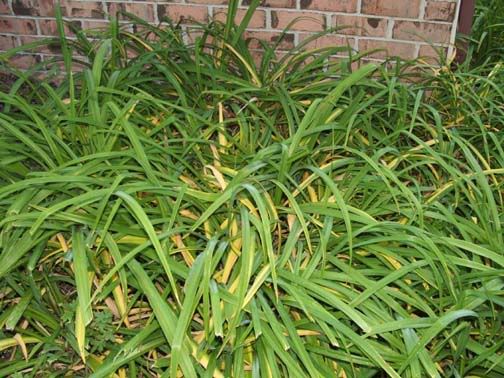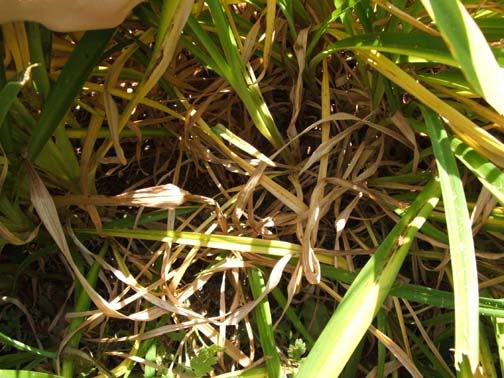Overcrowded daylilies
Gardening Reference » Gardening in 2006
« Prev thread: Over Wintering Strawberries - Zone 5b/6a| Next thread: overfertilizing roses »
Back to Thread index
Back to Thread index
by tkhooper on May 27, 2006 04:33 AM
I had a situation like that with one like that once and it didn't bloom until I divided it. Then I had plants galore and plenty of blooms. But the ones I had bloomed in late summer not now. So I don't have any specific information for yours. Good luck with them.
* * * *


* * * *


by johnCT on May 27, 2006 04:51 AM
Those plants look fine. It is pretty normal to get a few yellowing leaves. ust pull them off and hope it's not RUST! ![[shocked]](im/graemlins/shock.gif) It's also normal for different varieties to bloom at different times. You can wait and divide them early next spring if you like because blooms do suffer a bit when the clumps get too large.
It's also normal for different varieties to bloom at different times. You can wait and divide them early next spring if you like because blooms do suffer a bit when the clumps get too large.
* * * *
John - Zone 6
![[shocked]](im/graemlins/shock.gif) It's also normal for different varieties to bloom at different times. You can wait and divide them early next spring if you like because blooms do suffer a bit when the clumps get too large.
It's also normal for different varieties to bloom at different times. You can wait and divide them early next spring if you like because blooms do suffer a bit when the clumps get too large.* * * *
John - Zone 6
by netwiz on May 27, 2006 05:08 AM
Thanks for the info. I just looked up daylily rust and don't think that is the problem. I'll wait and see what happens before dividing. I don't have the new area ready for them yet anyway.
One last question... do the buds look different on various varieties of daylilies? We seem to have two very different type buds popping up. I hope this means they are not all the same kind! <keeping my fingers crossed>
Joanne
One last question... do the buds look different on various varieties of daylilies? We seem to have two very different type buds popping up. I hope this means they are not all the same kind! <keeping my fingers crossed>
Joanne
by weezie13 on May 27, 2006 05:18 AM
Alot of times you'll find cause it's at the
base of a house, you get a different micro~climate and it's alot hotter there..
Water a little more *and that will also mean,
more flowers, they like alot of water from spring time on to produce abundance of blooms*
Also, if it's a raised bed, it drains faster so that means even hotter..
And those look like the orange daylilies,
and those are extremely hardy and tough...
* * * *
Weezie
Don't forget to be kind to strangers. For some who have
done this have entertained angels without realizing it.
- Bible - Hebrews 13:2



http://photobucket.com/albums/y250/weezie13/
base of a house, you get a different micro~climate and it's alot hotter there..
Water a little more *and that will also mean,
more flowers, they like alot of water from spring time on to produce abundance of blooms*
Also, if it's a raised bed, it drains faster so that means even hotter..
And those look like the orange daylilies,
and those are extremely hardy and tough...
* * * *
Weezie
Don't forget to be kind to strangers. For some who have
done this have entertained angels without realizing it.
- Bible - Hebrews 13:2



http://photobucket.com/albums/y250/weezie13/
by netwiz on May 27, 2006 05:48 AM
Hi Weezie,
We've had a lot of chilly weather and rain here the past week or two. Could the yellowing be caused from too much water? That would make sense considering how wet things have been.
The orange daylilies are pretty. I'm hoping to mix in a variety over the next few years once I see what is already here.
Joanne
We've had a lot of chilly weather and rain here the past week or two. Could the yellowing be caused from too much water? That would make sense considering how wet things have been.
The orange daylilies are pretty. I'm hoping to mix in a variety over the next few years once I see what is already here.
Joanne
by netwiz on May 27, 2006 05:50 AM
Oh wait, if the yellowing was from too much water then all the daylilies would be doing the same. Nevermind!! I'll check the area and see if they need a drink.
Joanne
Joanne
by netwiz on May 31, 2006 03:30 AM
We figured out what our daylily problem is. The downspout in that corner is not working properly and the flower bed was being flooded during heavy rain. We fixed the downspout but the daylilies don't seem to be faring too well. Here are pictures from this morning:


The undergrowth is almost completely dead now. Will these come back next year so I can divide and move them or do I need to do that now? The ground is still damp but should dry out soon with the sudden heat wave we are having. Being a complete newbie to gardening, I have no idea what to do!
Joanne


The undergrowth is almost completely dead now. Will these come back next year so I can divide and move them or do I need to do that now? The ground is still damp but should dry out soon with the sudden heat wave we are having. Being a complete newbie to gardening, I have no idea what to do!
Joanne
by weezie13 on May 31, 2006 04:52 AM
Have you had any critters tunneling under it?
My only other thought would be that the house and the base of the house is too hot for that type of plant..
They are extremely winter hardy, found along road sides and can take cold...
I see your house is brick, which can be warm, and the base of the house can be warm and if it's in a sunny location adds yet more warmth..
Or a grub like that is feeding on the roots may also be the culprit??
*Mine are being trampled to death by 4 baby fluff~ball woodchucks.., but I'll have to check under mine to see what mine look like..
We've been havin' some funky weather and temps'*
* * * *
Weezie
Don't forget to be kind to strangers. For some who have
done this have entertained angels without realizing it.
- Bible - Hebrews 13:2



http://photobucket.com/albums/y250/weezie13/
My only other thought would be that the house and the base of the house is too hot for that type of plant..
They are extremely winter hardy, found along road sides and can take cold...
I see your house is brick, which can be warm, and the base of the house can be warm and if it's in a sunny location adds yet more warmth..
Or a grub like that is feeding on the roots may also be the culprit??
*Mine are being trampled to death by 4 baby fluff~ball woodchucks.., but I'll have to check under mine to see what mine look like..
We've been havin' some funky weather and temps'*
* * * *
Weezie
Don't forget to be kind to strangers. For some who have
done this have entertained angels without realizing it.
- Bible - Hebrews 13:2



http://photobucket.com/albums/y250/weezie13/
by lilylu on May 31, 2006 06:43 AM
by netwiz on May 31, 2006 07:04 AM
I'm hoping now that the downspout is fixed the area will dry out. I was planning on dividing and moving the whole bunch this fall but don't know what to do with them now. I'll dig one up to see what the roots look like and let you know. Thanks!
Joanne
Joanne
by lilylu on May 31, 2006 07:08 AM
by BrianD. on May 31, 2006 10:07 AM
Netwiz, although you have some yellowing your lillies should be fine. Overcrowding can cause some of this due to competition for nutrients. If you are moving them you will find that it is fairly difficult to kill these plants. They tolerate alot more than many other perenials. Just remember that if the new location has a much different climate (more sun, less sun) you may have some initial adjustment time for the plants depending on their preferences. Give them a little love and they reward you with a lot of love. If you find that they are the same color, you will find that a lot of other gardeners will be happy to trade with you for different colors. Just a thought.
* * * *
Brian D.
* * * *
Brian D.
« Prev thread: Over Wintering Strawberries - Zone 5b/6a| Next thread: overfertilizing roses »
Back to Thread index
Back to Thread index
Search The Garden Helper:

Thanks!
Joanne